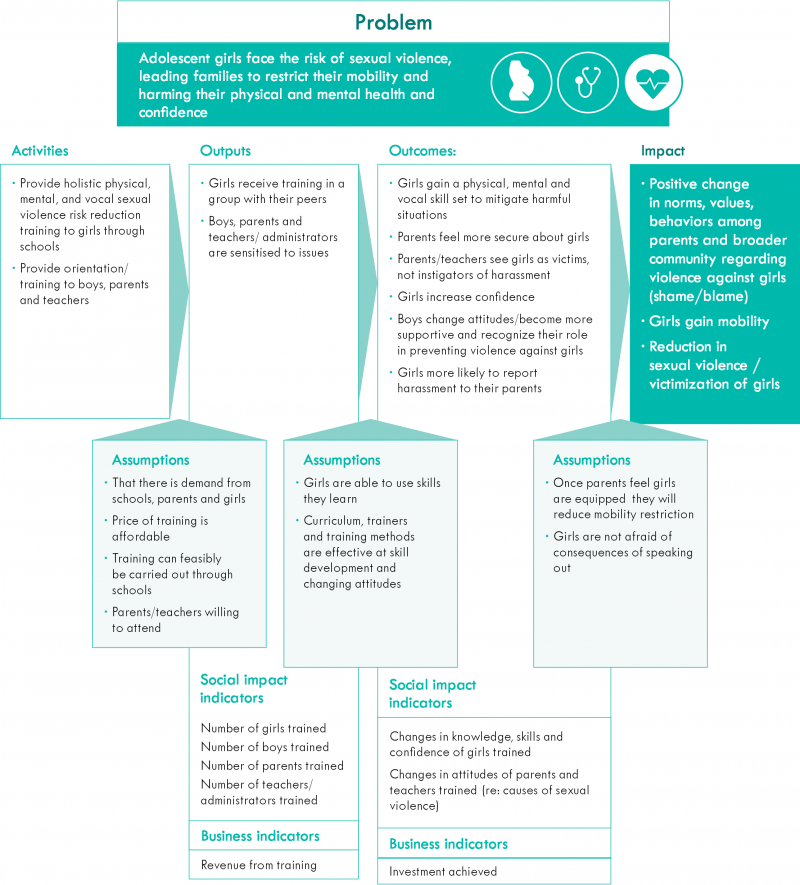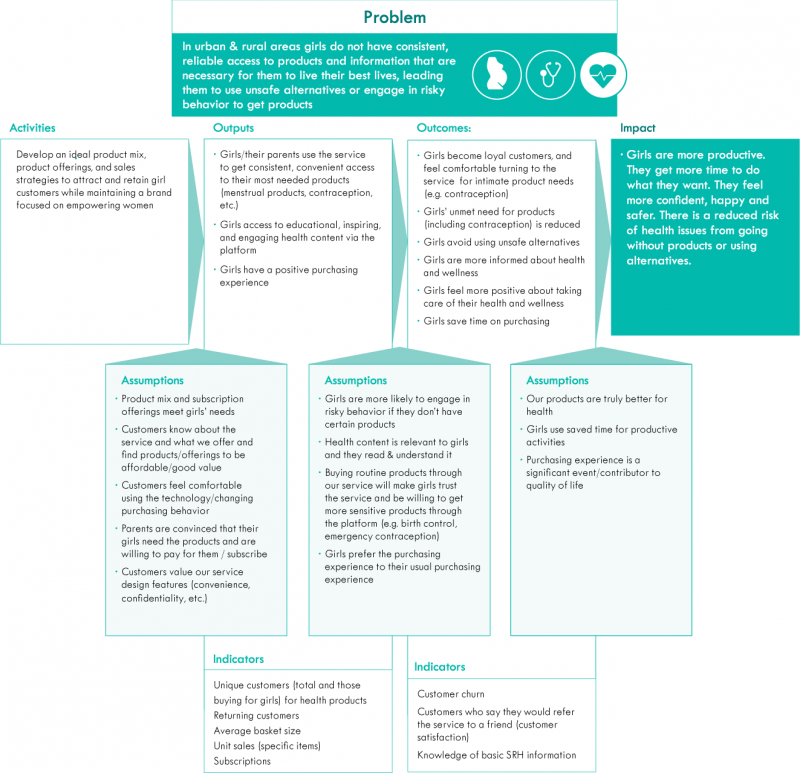Girl impact measurement example: Fightback
Business overview: Fightback is a security company that provides school-based sexual violence risk reduction training for girls.
Theory of Change: Girls trained by Fightback gain knowledge and develop skills and self-confidence to help them identify and mitigate harmful situations, which reduces their likelihood of being victimised. Parents and teachers educated on sexual violence issues through the programme experience a change in attitudes, helping to shift social norms that can lead to victim blaming and discourage reporting of incidents. (See below for ToC diagram.)
Key metrics: The table below shows the key metrics that Fightback is currently using to assess impact.
| Metrics | Data Collection | |
|---|---|---|
| Output | The number of girls trained The number of parents and teachers oriented |
Track through routine attendance records |
| Outcome | Changes in girls’ knowledge, skills and confidence Changes in parents’ and teachers’ attitudes |
Administer short surveys before and after the sessions |
Impact measurement journey: Fightback began measuring impact using attendance and survey data gathered as part of routine operations. When the company started to look for investment to scale, some investors required higher-level evidence of impact. Fightback partnered with Coffey International to conduct a longer-term study with a control group, tracking outcomes such as knowledge, skills and confidence over a longer period.
The next step in Fightback’s impact measurement journey may be to study the programme’s effects on reducing the incidence of sexual violence – a more complicated outcome to measure. While there is credible evidence from programmes in other settings that holistic self-defence training can reduce the occurrence of rape, this has not yet been proven for Fightback specifically. Should Fightback wish to conduct its own randomised controlled trial, it will require significant resources from investors and a professional research partner.
Further resources: https://impacttoolkit.thegiin.org/
Girl Impact Measurement Example: Kasha
About: Kasha is a female-focused e-commerce business in Rwanda and Kenya that aims to improve women’s and girls’ access to essential health and self-care products, such as contraception and sanitary pads.
Theory of Change: Girls who use Kasha will be more informed on health issues and will have greater access to their most needed health and self-care products, helping to reduce the unmet need for contraception (an important outcome related to Sustainable Development Goal #3). (See ToC diagram below.)
Key metrics: The list below shows the key metrics that Kasha is currently measuring (please note these are slightly different from the indicators listed on the ToC diagram, as the latter include indicators that will be measured in the future).
- # of women who purchased health products (can be contraceptives or any other pharmaceutical product on the website)
- # of women who purchased contraceptives
- # of women who purchased sanitary products
- # of low-income customers
- # of low-income customers who purchase contraceptives
- # of low-income customers who purchase sanitary pads
- # of students served (Rwanda only)
- # of contraceptives orders placed by young people
- # of health education sessions
Impact measurement journey: In Kasha’s first few years of operation, impact measurement has focused on outputs. Kasha began by putting mechanisms in place to track the age and gender of customers, either by collecting data through its website and app, or through in-person interactions with sales agents. Given the importance of customer confidentiality to its impact model, Kasha had to balance the need for data with the risk of scaring away customers, and think carefully about how and at which point in the customer journey to collect this information. This sometimes meant having to settle for incomplete data or use estimates/assumptions.
Although reducing the unmet need for contraception is an important outcome, measuring it is not critical for Kasha at this stage. Instead, the company is remaining focused on building a loyal customer base and driving demand. It measures/monitors customer satisfaction as a proxy for the specific benefits it provides to customers.

